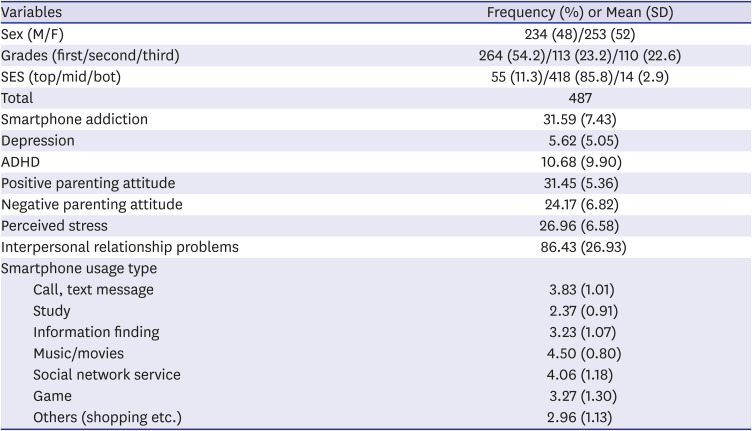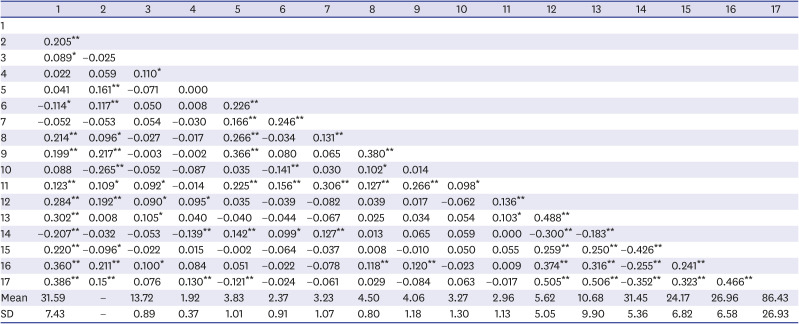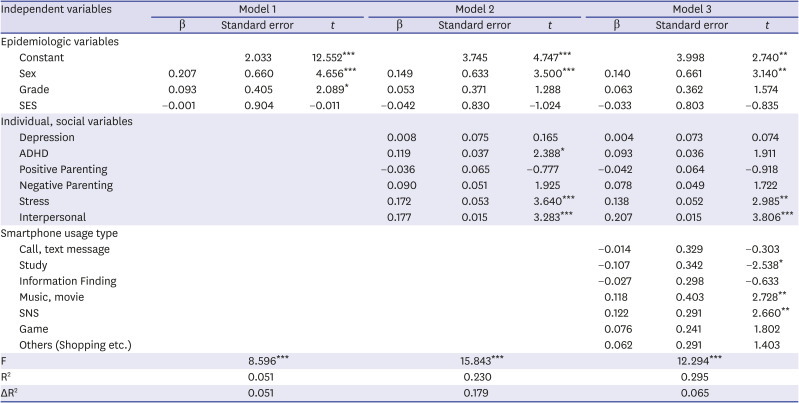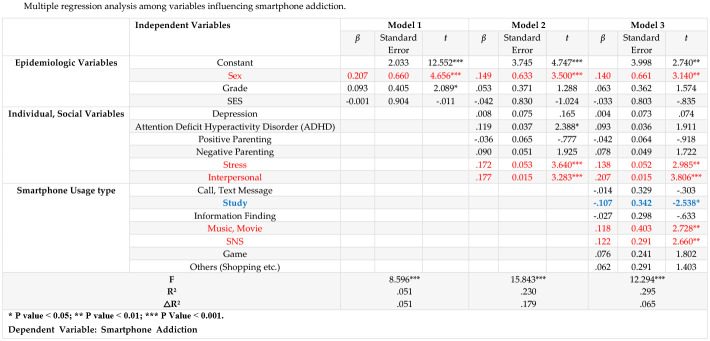1. Samaha M, Hawi NS. Relationships among smartphone addiction, stress, academic performance, and satisfaction with life. Comput Human Behav. 2016; 57:321–325.

2. Lee J, Ahn JS, Min S, Kim MH. Psychological characteristics and addiction propensity according to content type of smartphone use. Int J Environ Res Public Health. 2020; 17(7):2292.

3. Korea Information Society Promotion Agency. Analysis of Cell Phone Retention and Usage Behavior of Children and Adolescents. Seoul, Korea: KIDIS STAT Report;2019.
4. Yeo JY, Kang SY, Kim DH. The impact of attachment anxiety on smart phone addiction with a mediating effect of impulsivity and loneliness: focused on the group of SNS and GAME. Korean J Youth Couns. 2014; 22(1):47–69.
5. Adisetiyo V, Gray KM. Neuroimaging the neural correlates of increased risk for substance use disorders in attention-deficit/hyperactivity disorder: a systematic review. Am J Addict. 2017; 26(2):99–111. PMID:
28106934.
6. Sussman CJ, Harper JM, Stahl JL, Weigle P. Internet and video game addictions: diagnosis, epidemiology, and neurobiology. Child Adolesc Psychiatr Clin N Am. 2018; 27(2):307–326. PMID:
29502753.
7. Korea Information Society Promotion Agency. The survey on smartphone overdependence. Seoul, Korea: Korea Information Society Promotion Agency;2019.
8. Van Deursen AJ, Bolle CL, Hegner SM, Kommers PA. Modeling habitual and addictive smartphone behavior: the role of smartphone usage types, emotional intelligence, social stress, self-regulation, age, and gender. Comput Human Behav. 2015; 45:411–420.
9. Demirci K, Orhan H, Demirdas A, Akpinar A, Sert H. Validity and reliability of the Turkish Version of the Smartphone Addiction Scale in a younger population. Klinik Psikofarmakoloji Bülteni-Bull Clin Psychopharmacol. 2014; 24(3):226–234.

10. Lee EJ, Kim YK, Lim SJ. Factors influencing smartphone addiction in adolescents. Child Health Nurs Res. 2017; 23(4):525–533.

11. Billieux J, Maurage P, Lopez-Fernandez O, Kuss DJ, Griffiths MD. Can disordered mobile phone use be considered a behavioral addiction? An update on current evidence and a comprehensive model for future research. Curr Addict Rep. 2015; 2(2):156–162.

12. Lee TY, Song BH. Smart-phone addiction and countermeasure: focusing on ethics education. Korean Crim Psychol Rev. 2017; 13(1):195–226.
13. Lin TT, Chiang YH. Investigating predictors of smartphone dependency symptoms and effects on academic performance, improper phone use and perceived sociability. IJMC. 2017; 15(6):655.

14. Jeong SH, Kim H, Yum JY, Hwang Y. What type of content are smartphone users addicted to?: SNS vs. games. Comput Human Behav. 2016; 54:10–17.

15. Lee CH, Kim KH, Jang SA. A Study on Policy Measures to Protect Youths with the Spread of Smartphone. Seoul, Korea: National Youth Policy Institute;2013.
16. Oh SC, Kim YK, Park JH. Latent profile analysis of smart device usage pattern in children: smart device addiction according to its usage pattern. Korean J Child Stud. 2020; 41(1):47–60.

17. Mahapatra S. Smartphone addiction and associated consequences: role of loneliness and self-regulation. Behav Inf Technol. 2019; 38(8):833–844.

18. Kneer J, Glock S. Escaping in digital games: the relationship between playing motives and addictive tendencies in males. Comput Human Behav. 2013; 29(4):1415–1420.

19. Park SB, Hwang HS. An exploratory study on factors influencing on smart phone addiction: focused on the application use of university students. Korean J Journalism Commun Stud. 2014; 58(4):289–311.
20. Korea Information Society Promotion Agency. Comprehensive Plan to Support Proper Use of Smartphones and Internet for Realization of a Healthy Smart Society. Seoul, Korea: Korea Information Society Promotion Agency;2016.
21. Hwang SM, Lee SA, Han DH. The psychological features by comorbidity in adolescent internet addiction groups: focusing on depression and impulse. Korean J Psychol Gen. 2013; 32(4):989–1002.
22. Thomée S, Härenstam A, Hagberg M. Mobile phone use and stress, sleep disturbances, and symptoms of depression among young adults--a prospective cohort study. BMC Public Health. 2011; 11(1):66. PMID:
21281471.

23. Seo CM, Lee JH, Choi TY, Kim JH, Shin IH, Woo JM. Study for relations between smart-phone addiction level and Korea youth self report. J Korean Soc Biol Ther Psychiatry. 2012; 18(2):223–230.
24. Park SG, Jo HS. The relationship between happiness, depression and smart phone addiction. Korean J Health Psychol. 2018; 23(4):1095–1102.
25. Lee HC, Hong MH, Oh CK, Shim SH, Jun YJ, Lee SB, et al. Smart-phone addiction, depression/anxiety, and self-esteem with attention-deficit hyperactivity disorder in Korean children. J Korean Acad Child Adolesc Psychiatry. 2015; 26(3):159–164.

26. Kim JH. The effects of parenting attitude and peer attachment on the self- regulated learning of adolescents mediated by mobile phone dependency. Forum Youth Cult. 2014; 39:41–61.

27. Lee HJ, Kim SK, Cheon SM. Meta-analysis on the relationship of parent-child relationship variable to youth internet and smartphone addiction. J Rehab Psychol. 2016; 23(2):329–348.
28. Lee EJ, Eo JK. The differences of the impulsivity and parenting attitude of the high school students according to the levels of the smartphone addiction. JLCCI. 2014; 4(1):1–17.
29. Kim BN, Ko EJ, Choi HG. A study on factors affecting smart-phone addiction in university students: a focus on differences in classifying risk groups. Stud Korean Youth. 2013; 24(3):67–98.
30. Lee EJ, Eo JK. The effects of perceived stress and impulsivity of high school students as well as the parents' parenting attitude on smartphone addiction. Fam Ther. 2015; 23(1):1–22.
31. Kim JU, Gawk TE. The mediating effects of job-seeking stress and interpersonal problems between adult attachment and smartphone addiction of college students. JLCCI. 2016; 16(10):1055–1076.

32. Chae YG. The influence of family functioning, marital conflict, self-esteem and spirituality well-being on aggression in adolescence. J Art Psychother. 2005; 1:74–90.
33. Jeon HS, Jang SO. A study on the influence of depression and stress on smartphone addiction among university students: focused on moderating effect of gender. Korean J Youth Stud. 2014; 21(8):103–129.
34. Shin K, Kim D, Jung Y, Lee J, Lee Y, Kim M. Development of Korean Smartphone Addiction Proneness Scale for Youth and Adults. Seoul, Korea: National Information Society Agency (NIA);2011.
35. Kroenke K, Spitzer RL, Williams JB. The PHQ-9: validity of a brief depression severity measure. J Gen Intern Med. 2001; 16(9):606–613. PMID:
11556941.
36. An JY, Seo ER, Lim KH, Shin JH, Kim JB. Standardization of the Korean version of screening tool for depression (Patient Health Questionnaire-9, PHQ-9). Korean Soc Biol Therap Psychiatry. 2013; 19(1):47–56.
37. DuPaul G, Power T, Anastopoulos A, Reid R, McGoey K, Ikeda M. Teacher ratings of attention deficit hyperactivity disorder symptoms: factor structure and normative data. Psychol Assess. 1997; 9(4):436–444.

38. Kim YS, So Y, Noh J, Choi N, Kim S, Koh Y. Normative data on the Korean ADHD Rating Scales(K-ARS) for parents and teacher. J Korean Neuropsychiatr Assoc. 2003; 42(3):352–359.
39. Huh MY. The study for the development and Validation of Parenting Behavior Inventory perceived by adolescent (Doctor's dissertation). Seoul: Ewha Women's University;1999.
40. Cohen S, Kamarck T, Mermelstein R. A global measure of perceived stress. J Health Soc Behav. 1983; 24(4):385–396. PMID:
6668417.

41. Park J, Seo Y. Validation of the Perceived Stress Scale (PSS) on samples of Korean university students. Korean J Psychol Gen. 2010; 29(3):611–629.
42. Hong SH, Park E, Kim YH, Kwon JH, Cho Y, Kim Y. Short form of the Korean Inventory of Interpersonal Problems Circumplex scales (KIIP-SC). Korean J Clin Psychol. 2002; 21(4):923–940.
43. Salehan M, Negahban A. Social networking on smartphones: when mobile phones become addictive. Comput Human Behav. 2013; 29(6):2632–2639.

44. Bian M, Leung L. Smartphone addiction: linking loneliness, shyness, symptoms and patterns of use to social capital. Media Asia. 2014; 41(2):159–176.

45. Lee C, Lee SJ. Prevalence and predictors of smartphone addiction proneness among Korean adolescents. Child Youth Serv Rev. 2017; 77:10–17.

46. Han SS, Oh KS. A study on cellular phone addiction symptom dependent on interpersonal relationship types and using inclination - focus on the case of undergraduates. Korean J Broadcast Telecommun Stud. 2006; 20(4):371–405.
47. Park JS. Relationship of social, interpersonal adjustment and internet use of college student: the practical use in counselling. Korean J Health Psychol. 2010; 15(2):357–367.
48. Joiner TE Jr, Catanzaro SJ, Laurent J. Tripartite structure of positive and negative affect, depression, and anxiety in child and adolescent psychiatric inpatients. J Abnorm Psychol. 1996; 105(3):401–409. PMID:
8772010.

49. Essau CA, Conradt J, Petermann F. Frequency and comorbidity of social phobia and social fears in adolescents. Behav Res Ther. 1999; 37(9):831–843. PMID:
10458047.
50. Dobson KS. The relationship between anxiety and depression. Clin Psychol Rev. 1985; 5(4):307–324.

51. Kendall PC, Brady EU. Comorbidity in the anxiety disorders of childhood: Implications for validity and clinical significance. In : Craig KD, Dobson KS, editors. Anxiety and Depression in Adults and Children. Thousand Oaks, CA, USA: Sage;1995. p. 3–36.







 PDF
PDF Citation
Citation Print
Print




 XML Download
XML Download